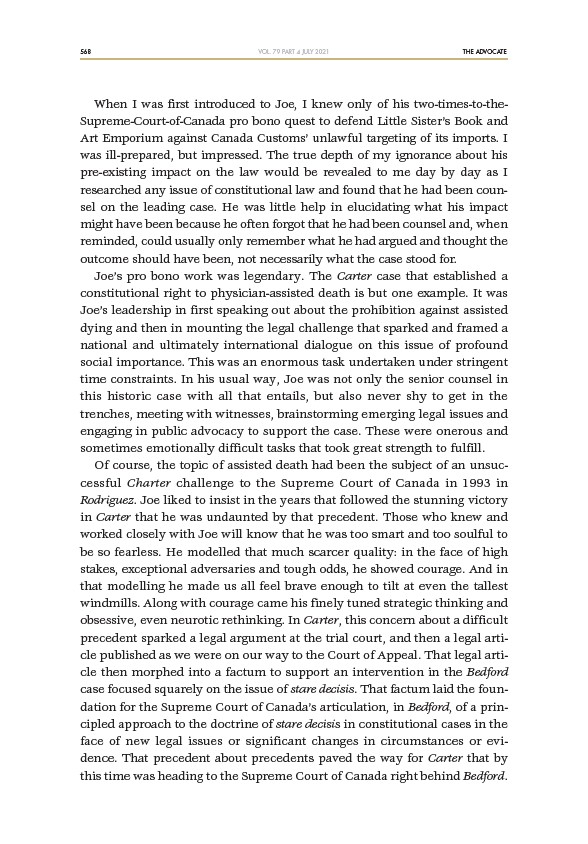
568 THE ADVOCATE
VOL. 79 PART 4 JULY 2021
When I was first introduced to Joe, I knew only of his two-times-to-the-
Supreme-Court-of-Canada pro bono quest to defend Little Sister’s Book and
Art Emporium against Canada Customs’ unlawful targeting of its imports. I
was ill-prepared, but impressed. The true depth of my ignorance about his
pre-existing impact on the law would be revealed to me day by day as I
researched any issue of constitutional law and found that he had been counsel
on the leading case. He was little help in elucidating what his impact
might have been because he often forgot that he had been counsel and, when
reminded, could usually only remember what he had argued and thought the
outcome should have been, not necessarily what the case stood for.
Joe’s pro bono work was legendary. The Carter case that established a
constitutional right to physician-assisted death is but one example. It was
Joe’s leadership in first speaking out about the prohibition against assisted
dying and then in mounting the legal challenge that sparked and framed a
national and ultimately international dialogue on this issue of profound
social importance. This was an enormous task undertaken under stringent
time constraints. In his usual way, Joe was not only the senior counsel in
this historic case with all that entails, but also never shy to get in the
trenches, meeting with witnesses, brainstorming emerging legal issues and
engaging in public advocacy to support the case. These were onerous and
sometimes emotionally difficult tasks that took great strength to fulfill.
Of course, the topic of assisted death had been the subject of an unsuccessful
Charter challenge to the Supreme Court of Canada in 1993 in
Rodriguez. Joe liked to insist in the years that followed the stunning victory
in Carter that he was undaunted by that precedent. Those who knew and
worked closely with Joe will know that he was too smart and too soulful to
be so fearless. He modelled that much scarcer quality: in the face of high
stakes, exceptional adversaries and tough odds, he showed courage. And in
that modelling he made us all feel brave enough to tilt at even the tallest
windmills. Along with courage came his finely tuned strategic thinking and
obsessive, even neurotic rethinking. In Carter, this concern about a difficult
precedent sparked a legal argument at the trial court, and then a legal article
published as we were on our way to the Court of Appeal. That legal article
then morphed into a factum to support an intervention in the Bedford
case focused squarely on the issue of stare decisis. That factum laid the foundation
for the Supreme Court of Canada’s articulation, in Bedford, of a principled
approach to the doctrine of stare decisis in constitutional cases in the
face of new legal issues or significant changes in circumstances or evidence.
That precedent about precedents paved the way for Carter that by
this time was heading to the Supreme Court of Canada right behind Bedford.